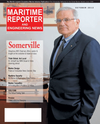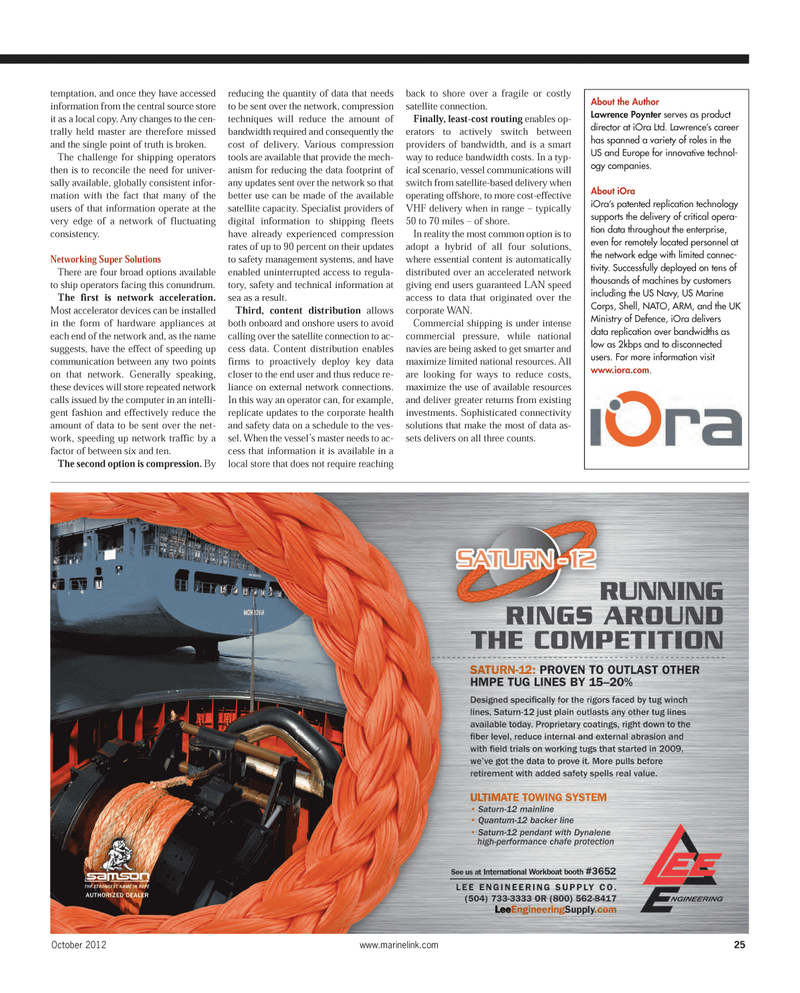
Page 25: of Maritime Reporter Magazine (October 2012)
Marine Design & Construction
Read this page in Pdf, Flash or Html5 edition of October 2012 Maritime Reporter Magazine
temptation, and once they have accessed information from the central source storeit as a local copy. Any changes to the cen- trally held master are therefore missedand the single point of truth is broken. The challenge for shipping operatorsthen is to reconcile the need for univer- sally available, globally consistent infor- mation with the fact that many of the users of that information operate at thevery edge of a network of fluctuating consistency. Networking Super Solutions There are four broad options available to ship operators facing this conundrum. The first is network acceleration. Most accelerator devices can be installed in the form of hardware appliances at each end of the network and, as the name suggests, have the effect of speeding up communication between any two points on that network. Generally speaking, these devices will store repeated network calls issued by the computer in an intelli-gent fashion and effectively reduce the amount of data to be sent over the net- work, speeding up network traffic by a factor of between six and ten. The second option is compression. Byreducing the quantity of data that needsto be sent over the network, compression techniques will reduce the amount ofbandwidth required and consequently thecost of delivery. Various compression tools are available that provide the mech- anism for reducing the data footprint ofany updates sent over the network so that better use can be made of the available satellite capacity. Specialist providers of digital information to shipping fleetshave already experienced compression rates of up to 90 percent on their updatesto safety management systems, and have enabled uninterrupted access to regula- tory, safety and technical information at sea as a result. Third, content distribution allows both onboard and onshore users to avoid calling over the satellite connection to ac- cess data. Content distribution enables firms to proactively deploy key data closer to the end user and thus reduce re-liance on external network connections. In this way an operator can, for example, replicate updates to the corporate healthand safety data on a schedule to the ves- sel. When the vessel?s master needs to ac- cess that information it is available in a local store that does not require reachingback to shore over a fragile or costly satellite connection.Finally, least-cost routing enables op-erators to actively switch between providers of bandwidth, and is a smart way to reduce bandwidth costs. In a typ- ical scenario, vessel communications will switch from satellite-based delivery when operating offshore, to more cost-effective VHF delivery when in range ? typically 50 to 70 miles ? of shore.In reality the most common option is toadopt a hybrid of all four solutions, where essential content is automaticallydistributed over an accelerated network giving end users guaranteed LAN speed access to data that originated over the corporate WAN. Commercial shipping is under intensecommercial pressure, while nationalnavies are being asked to get smarter and maximize limited national resources. All are looking for ways to reduce costs, maximize the use of available resources and deliver greater returns from existing investments. Sophisticated connectivity solutions that make the most of data as- sets delivers on all three counts. About the AuthorLawrence Poynter serves as productdirector at iOra Ltd. Lawrence?s career has spanned a variety of roles in theUS and Europe for innovative technol-ogy companies.About iOraiOra?s patented replication technology supports the delivery of critical opera- tion data throughout the enterprise,even for remotely located personnel atthe network edge with limited connec-tivity. Successfully deployed on tens of thousands of machines by customersincluding the US Navy, US Marine Corps, Shell, NATO, ARM, and the UK Ministry of Defence, iOra delivers data replication over bandwidths aslow as 2kbps and to disconnectedusers. For more information visit www.iora.com .October 2012www.marinelink.com 25MR#10 (18-25):MR Template 10/2/2012 11:04 AM Page 25

 24
24

 26
26
